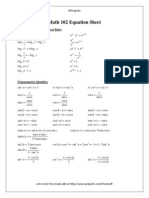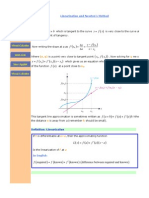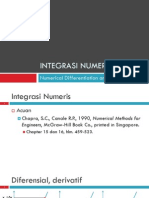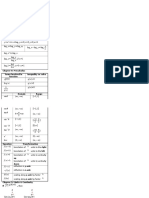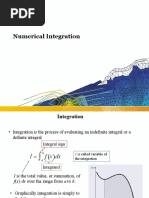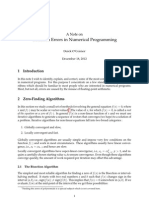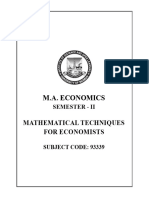Chapter 4 Numerical Differentiation and Integration 4.3 Elements of Numerical Integration
Uploaded by
masyuki1979Chapter 4 Numerical Differentiation and Integration 4.3 Elements of Numerical Integration
Uploaded by
masyuki1979Chapter 4 Numerical Differentiation and Integration
4.3 Elements of Numerical Integration
The need often arises for evaluating the definite integral of a function that has no
explicit antiderivative or whose antiderivative is not easy to obtain. The basic method
involved in approximating ( )
b
a
f x dx
is called numerical quadrature. It uses a sum
( )
0
n
i i
i
a f x
to approximate ( )
b
a
f x dx
.
The methods of quadrature in this section are based on the interpolation polynomials
given in Chapter 3. We first select a set of distinct nodes { }
0 1
, , ,
n
x x x L
from the
interval [ ]
, a b
. Then we integrate the Lagrange interpolating polynomial
( ) ( ) ( )
0
n
n i i
i
P x f x L x
and its truncation error term over [ ]
, a b
to obtain
( ) ( ) ( ) ( )
( ) ( )
( )
( )
( )
( ) ( ) ( )
( 1)
0 0
( 1)
0 0
1 !
1
1 !
n
b b b
n n
i i i
i i
a a a
b
n n
n
i i i
i i
a
f x
f x dx f x L x dx x x dx
n
a f x x x f x dx
n
+
+
+
+
+
+
where ( ) x
is in [ ]
, a b
for each
x
and
( )
b
i i
a
a L x dx
, for each
0,1, , i n L
.
The quadrature formula is, therefore,
( ) ( )
0
b
n
i i
i
a
f x dx a f x
,
with error given by
( )
( )
( ) ( ) ( )
( 1)
0
1
1 !
b
n
n
i
i
a
E f x x f x dx
n
+
.
Before discussing the general situation of quadrature formulas, let us consider
formulas produced by using first and second Lagrange polynomials with equally
spaced nodes. This gives the Trapezoidal rule and Simpsons rule, which are
commonly introduced in calculus courses.
1
To derive the Trapezoidal rule for approximating ( )
b
a
f x dx
, let
0 1
, x a x b
,
h b a and use the linear Lagrange polynomial:
( )
( )
( )
( )
( )
( )
( )
1 0
1 0 1
0 1 1 0
x x x x
P x f x f x
x x x x
+
.
Then,
( )
( )
( )
( )
( )
( )
( ) ( ) ( ) ( ) ( )
1 1
0 0
1 0
0 1 0 1
0 1 1 0
1
2
x x b
a x x
x x x x
f x dx f x f x dx f x x x x x dx
x x x x
1
+ +
1
]
Since ( ) ( )
0 1
x x x x
does not change sign on [ ]
0 1
, x x
, the Weighted Mean Value
Theorem for Integrals can be applied to the error term to give, for some ( )
0 1
in , x x
,
( ) ( ) ( ) ( ) ( ) ( ) ( )
( )
( )
( )
1 1
0 0
1
0
0 1 0 1
3 3
1 0
0 1
.
3 2 6
x x
x x
x
x
f x x x x x dx f x x x x dx
x x
x h
f x x x f
+ 1
+
1
]
Thus, we have
( )
( )
( )
( )
( )
( )
( ) ( )
( )
( ) ( ) ( )
1
0
2 2
3
1 0
0 1
0 1 1 0
3
1 0
0 1
2 2 12
.
2 12
x
b
a
x
x x x x
h
f x dx f x f x f
x x x x
x x
h
f x f x f
1
+ 1
1
]
+ 1
]
Since
1 0
h x x
, we have the following rule:
Trapezoidal Rule:
( ) ( ) ( ) ( )
3
0 1
.
2 12
b
a
h h
f x dx f x f x f + 1
]
This is called the Trapezoidral rule because when
f
is a function with positive
values, ( )
b
a
f x dx
is approximated by the area in a trapezoid, as shown in Figure 4.3.
Since the error term for the Trapezoidral rule involves
f
, the rule gives the exact
result when applied to any function whose second derivative is identically zero, that
is, any polynomial of degree one or less.
2
Simpsons rule results from integrating over [ ]
, a b
the second Lagrange polynomial
with nodes
0 2
, x a x b
, and
1
x a h +
, where ( ) 2 h b a
. (See Figure 4.4).
Therefore,
( )
( ) ( )
( ) ( )
( )
( ) ( )
( ) ( )
( )
( ) ( )
( ) ( )
( )
( ) ( ) ( )
( ) ( )
1
0
3
0
1 2 0 2
0 1
0 1 0 2 1 0 1 2
0 1 0 1 3 (3)
2
2 0 2 1
.
6
x b
a x
x
x
x x x x x x x x
f x dx f x f x
x x x x x x x x
x x x x x x x x x x
f x dx f x dx
x x x x
+
1
+ +
1
]
Similarly, we have the following rule:
Simpsons Rule:
( ) ( ) ( ) ( ) ( )
5
(4)
0 1 2
4 .
3 90
b
a
h h
f x dx f x f x f x f + + 1
]
Since the error term involves the fourth derivative of
f
, Simpsons rule gives exact
results when applied to any polynomial of degree three or less.
4.4 Composite Numerical Integration
Theorem 4.4 Let [ ]
4
, f C a b
,
n
be even, ( ) h b a n
, and
j
x a jh +
, for each
0,1, , . j n L
There exists a ( ) , a b
for which the Composite Simpsons rule for
n
subintervals can be written with its error term as
( ) ( ) ( ) ( ) ( )
( )
( )
1
4
2 2
(4)
2 2 1
1 1
2 4 .
3 180
n n
b
j j
j j
a
b a h
h
f x dx f a f x f x f b f
1
+ + +
1
1
]
Algorithm 4.1 uses the Composite Simpsons rule on
n
subintervals. This is the most
frequently used general-purpose quadrature algorithm.
Algorithm 4.1 Composite Simpsons Rule
To approximate the integral ( ) :
b
a
I f x dx
Input: endpoints
, ; a b
even positive integer
n
.
Output: approximation to XI I .
Step 1 ( ) h b a n
Step 2 ( ) ( ) 0 XI f a f b +
3
1 0 XI (*summation of ( )
2 1 i
f x
*)
2 0 XI (*summation of ( )
2i
f x
*)
Step 3 DO
1, 1 i n
Step 4 X a ih +
Step 5 If i is even then
( ) 2 2 XI XI f X +
Else
( ) 1 1 XI XI f X +
End If
Step 6 ( 0 2* 2 4* 1) 3 XI h XI XI XI + +
Step 7 Output ( ) XI
Stop
The Algorithm 4.1 can be described in the following SUBROUTINE.
SUBROUTINE SIMPSONS(N,A,B,F,XI)
C================================================
C ALGORITHM 4.1 Composite Simpson's rule
C PURPOSE
C Using Composite Simpson's rule,
C approximate I = INTEGRAL(f(x) dx)) from A TO B:
C INPUT Endpoints A and B; even positive number N; function f
C OUTPUT Approximation XI TO I
C
C--------------------------------------------------------------------------------
C
INTEGER N
REAL A,B,XI,
EXTERNAL F
REAL H,X,XI0,XI1,XI2
INTEGER I
H = (B-A)/N
XI0 = F(A)+F(B)
C *** Summation of f(x(2*i-1)) ***
4
XI1 = 0.0
C *** Summation of f(x(2*i)) ***
XI2 = 0.0
DO 10 I = 1,N-1
X = A+I*H
IF (I.EQ.(2*(I/2))) THEN
XI2 = XI2+F(X)
ELSE
XI1 = XI1+F(X)
END IF
10 CONTINUE
XI = H*(XI0+2.0*XI2+4.0*XI1)/3.0
WRITE(*,29) A,B,XI
29 FORMAT(1X,'Integral of F from',3X,F4.1,3X,'TO',3X,F10.6,3X,'is'
1 ,3X,F12.6)
RETURN
END
Example 1 Consider approximating
0
sin xdx
with an absolute error less than
0.00002, using the Composite Simpsons rule.
The Composite Simpsons rule gives, for some ( ) in 0,
,
( ) ( ) ( ) ( ) ( ) ( )
1
4
2 2
2 2 1
1 1
0
sin sin 0 2 sin 4 sin sin sin .
3 180
n n
j j
j j
h h
x dx x x
1
1
+ + +
1
1
]
Since the absolute error to be less than 0.00002, the inequality
4 4 5
4
sin 0.0002
180 180 180
h h
n
<
is used to determine
n
and h . Completing these calculations gives
( ) 18 17.075 n n >
.
If 18 n , we use Algorithm 4.1 (see code C4p1.f) and the formula gives
( ) ( )
( )
( )
8 9
1 1
2 1
sin sin 0 2 sin 4 sin sin 2.000010
54 9 18
b
j j
a
j
j
x dx
1 _
_
+ + +
1
, 1
, ]
The exact answer is 2, so Composite Simpsons rule with 18 n gave an answer well
5
within the required error bound.
Code C4p1.f:
C*****************************************************************
C
C Example 1 (pp201): Using Composite Simpson's rule
C approximate I = INTEGRAL(sinx dx)) from 0 TO PI:
C
C Input: Even positive number N
C
C Outpou: Approximation XI TO I
C****************************************************************
C
INTEGER N
REAL A,B,XI,PI
EXTERNAL F
OPEN(UNIT=10,FILE='c0.doc',STATUS='UNKNOWN')
PI = 3.1415926
A = 0.0
B = PI
N = 18
CALL SIMPSONS(N,A,B,F,XI)
WRITE(10,29) A,B,XI
29 FORMAT(1X,'Integral of F from',3X,F4.1,3X,'TO',3X,F10.6,3X,'is'
1 ,3X,F12.6)
STOP
END
C
REAL FUNCTION F(X)
C====================================
C PURPOSE
C Find the value of function sin(x)
C-------------------------------------------------------------
C
REAL X
INTRINSIC SIN
F = SIN(X)
RETURN
END
The extension of the Trapezoidal rule (see Figure 4.8) is given. Since the Trapezoidal
6
rule requires only one interval for each application, the integer
n
can be either odd or
even.
Theorem 4.5 Let [ ]
2
, f C a b
, ( ) h b a n
, and
j
x a jh +
, for each
0,1, , . j n L
There exists a ( ) , a b
for which the Composite Trapezoidal rule for
n
subintervals can be written with its error term as
( ) ( ) ( ) ( )
( )
( )
2
1
1
2 .
2 12
b
n
j
j
a
b a h
h
f x dx f a f x f b f
1
+ +
1
]
Algorithm 4.1T Composite Trapezoidal Rule
To approximate the integral ( )
b
a
I f x dx
.
Input: endpoints
, ; a b
positive integer N, function ( ) f x
.
Output: approximation to XI I .
Step 1 ( ) h b a n
Step 2 ( ) ( ) 0 XI f a f b +
1 0 XI (*summation of ( )
i
f x
*)
Step 3 DO
1, 1 i n
Step 4 X a ih +
( ) 1 1 XI XI f X +
Step 5 ( ) * 0 1 / 2 XI h XI XI +
Step 6 Output ( ) XI
Stop
SUBROUTINE TRAPEZOIDAL(N,A,B,F,XI)
C=================================================
C ALGORITHM 4.1 Composite Trapezoidal rule
C PURPOSE
C Using Composite Trapezoidal rule
C approximate I = INTEGRAL(f(x) dx)) from A TO B.
C INPUT Endpoints A and B; positive integer number N; function f
C OUTPUT Approximation XI TO I
C
C-----------------------------------------------------------------------------------
7
C
INTEGER N
REAL A,B,XI
EXTERNAL F
REAL H,XI0,XI1
INTEGER I
H = (B-A)/N
XI0 = F(A)+F(B)
C *** Summation of f(x(i)) ***
XI1 = 0.0
DO 10 I = 1,N-1
X = A+I*H
XI1 = XI1+F(X)
10 CONTINUE
XI = H*(XI0+2.0*XI1)/2.0
WRITE(*,29) A,B,XI
29 FORMAT(1X,'Integral of F from',3X,F4.1,3X,'TO',3X,F10.6,3X,'is'
1 ,3X,F12.6)
RETURN
END
C
Example 2 Consider approximating
0
sin xdx
with an absolute error less than
0.00002, using the Composite Trapezoidal rule.
The Composite Trapezoidal rule gives, for some ( ) in 0,
,
( ) ( ) ( ) ( ) ( )
2 1
1
0
sin sin 0 2 sin sin sin .
2 12
n
j
j
h h
x dx x
1
+ +
1
]
Since the absolute error to be less than 0.00002, the inequality
( )
2 2 3
2
sin 0.00002
12 12 12
h h
n
<
is used to determine
n
and h . Completing these calculations gives
( ) 360 359.434 n n >
.
If 360 n , we use Algorithm 4.1T (see code C4p1T.f) and the formula gives
8
( ) ( ) ( )
359
1
0
sin sin 0 2 sin sin 1.999987
720 360
j
j
x dx
1
_
+ +
1
,
]
.
If 18 n , we use Algorithm 4.1T (see code C4p1T.f) and the formula gives
( ) ( ) ( )
17
1
0
sin sin 0 2 sin sin 1.994920
36 18
j
j
x dx
1
_
+ +
1
,
]
.
From the above two equations, it can be seen that the Composite Trapezoidal rule
with 360 n gave an answer well within the required error bound. However, the
Composite Trapezoidal rule with 18 n clearly did not.
Homework 6
Exercise set 4.4
Q7. Determine the values of
n
and h required to approximate ( )
2
2
0
sin 3
x
e x dx
to
within
4
10
and find the approximation.
(a) Use the Composite Trapezoidal rule (using Algorithm 4.1T and C4p1T.f).
(b) Use the Composite Simpsons rule (using Algorithm 4.1 and C4p1.f).
9
You might also like
- Frame Optimization by Means of Algorithm - MaestrelliNo ratings yetFrame Optimization by Means of Algorithm - Maestrelli16 pages
- Calc 1 Lecture Notes Section 4.7 1 of 8: FXDXM FC X Ba X N C A XiNo ratings yetCalc 1 Lecture Notes Section 4.7 1 of 8: FXDXM FC X Ba X N C A Xi8 pages
- Essential Calculus, James Stewart: Techniques of IntegrationNo ratings yetEssential Calculus, James Stewart: Techniques of Integration36 pages
- Advanced Computational Methods: Numerical IntegrationNo ratings yetAdvanced Computational Methods: Numerical Integration59 pages
- Y MX B: Linearization and Newton's MethodNo ratings yetY MX B: Linearization and Newton's Method7 pages
- Numerical Differentiation: X X X H X H X HNo ratings yetNumerical Differentiation: X X X H X H X H19 pages
- Lecture 19 - Numerical Integration: CVEN 302 July 16, 2001No ratings yetLecture 19 - Numerical Integration: CVEN 302 July 16, 200146 pages
- Homework 2 Solutions: G (0) 1 and G (1) 1/2. Therefore G (X) Is in (0,1) For All X in (0,1) - and Since G IsNo ratings yetHomework 2 Solutions: G (0) 1 and G (1) 1/2. Therefore G (X) Is in (0,1) For All X in (0,1) - and Since G Is6 pages
- Calculus Review and Formulas: 1 FunctionsNo ratings yetCalculus Review and Formulas: 1 Functions11 pages
- Collomb-Tutorial On Trigonometric Curve FittingNo ratings yetCollomb-Tutorial On Trigonometric Curve Fitting15 pages
- Chapter 12-b: Integral Calculus - ExtraNo ratings yetChapter 12-b: Integral Calculus - Extra24 pages
- Calculus 141, Section 8.6 The Trapezoidal Rule & Simpson's RuleNo ratings yetCalculus 141, Section 8.6 The Trapezoidal Rule & Simpson's Rule4 pages
- Integrals: Definitions Definite Integral: Suppose Anti-Derivative: An Anti-Derivative ofNo ratings yetIntegrals: Definitions Definite Integral: Suppose Anti-Derivative: An Anti-Derivative of5 pages
- Limits and Continuity: - Definition - Evaluation of Limits - Continuity - Limits Involving Infinity100% (1)Limits and Continuity: - Definition - Evaluation of Limits - Continuity - Limits Involving Infinity41 pages
- Financial Mathematics Course FIN 118 Unit Course 4 Number Unit Integral Calculus Unit SubjectNo ratings yetFinancial Mathematics Course FIN 118 Unit Course 4 Number Unit Integral Calculus Unit Subject17 pages
- Chapter 19 Numerical Differentiation: Taylor Polynomials Lagrange InterpolationNo ratings yetChapter 19 Numerical Differentiation: Taylor Polynomials Lagrange Interpolation29 pages
- IIT-JEE 2004 Mains Questions & Solutions - Maths - Version 2 (The Questions Are Based On Memory)No ratings yetIIT-JEE 2004 Mains Questions & Solutions - Maths - Version 2 (The Questions Are Based On Memory)15 pages
- Roots of Equations: Numerical Methods For Civil EngineersNo ratings yetRoots of Equations: Numerical Methods For Civil Engineers21 pages
- Fourier Series Section 11.1: MATH 5311 - Advanced Engineering MathNo ratings yetFourier Series Section 11.1: MATH 5311 - Advanced Engineering Math19 pages
- Some Standard Integration Techniques: 1 The Fundamental Theorem of CalculusNo ratings yetSome Standard Integration Techniques: 1 The Fundamental Theorem of Calculus24 pages
- O'Connor - Common Errors in Numerical ProgrammingNo ratings yetO'Connor - Common Errors in Numerical Programming17 pages
- Trigonometric Ratios to Transformations (Trigonometry) Mathematics E-Book For Public ExamsFrom EverandTrigonometric Ratios to Transformations (Trigonometry) Mathematics E-Book For Public Exams5/5 (1)
- 3.8, δ and d notations for changes: Large changes: We use the Greek symbolNo ratings yet3.8, δ and d notations for changes: Large changes: We use the Greek symbol7 pages
- Chaper11 Differentiability On 11.1 Partial Derivatives and Partial Integrals Def: (Cartesian Product)No ratings yetChaper11 Differentiability On 11.1 Partial Derivatives and Partial Integrals Def: (Cartesian Product)6 pages
- DX X F: More On Substitution 1. If, Evaluate The Following Integrals in Terms of KNo ratings yetDX X F: More On Substitution 1. If, Evaluate The Following Integrals in Terms of K2 pages
- Calc 2 Lecture Notes Section 5.7 1 of 7: DX X FNo ratings yetCalc 2 Lecture Notes Section 5.7 1 of 7: DX X F7 pages
- MTH132 Section 1 & 12, Quiz 3: Name (Print Clearly) : Student NumberNo ratings yetMTH132 Section 1 & 12, Quiz 3: Name (Print Clearly) : Student Number2 pages
- Week 11: Complex Numbers and Vectors Complex Numbers: Powers of JNo ratings yetWeek 11: Complex Numbers and Vectors Complex Numbers: Powers of J8 pages
- Chemistry 1S - DR Paul May: Calculus Question For January Exam 2006No ratings yetChemistry 1S - DR Paul May: Calculus Question For January Exam 20062 pages
- Chemistry 1S - Prof Paul May: A Is A Constant. An Accurate Plot On Graph-Paper Is Not Required. (5 Marks)No ratings yetChemistry 1S - Prof Paul May: A Is A Constant. An Accurate Plot On Graph-Paper Is Not Required. (5 Marks)3 pages
- Chemistry 1S - DR Paul May: Calculus Question For January Exam 2008No ratings yetChemistry 1S - DR Paul May: Calculus Question For January Exam 20082 pages
- Chemistry 1S - DR Paul May: Calculus Question For January Exam 2005No ratings yetChemistry 1S - DR Paul May: Calculus Question For January Exam 20052 pages
- Chemistry 1S - DR Paul May: Calculus Question For January Exam 2009No ratings yetChemistry 1S - DR Paul May: Calculus Question For January Exam 20093 pages
- Chemistry 1S - DR Paul May: Calculus Question For January Exam 2007No ratings yetChemistry 1S - DR Paul May: Calculus Question For January Exam 20072 pages
- Full Download (Ebook) Linear algebra: An introduction by Richard Bronson, Gabriel B. Costa ISBN 9780120887842, 0120887843 PDF DOCX100% (2)Full Download (Ebook) Linear algebra: An introduction by Richard Bronson, Gabriel B. Costa ISBN 9780120887842, 0120887843 PDF DOCX81 pages
- Mathematical Techniques For Economists English VersionNo ratings yetMathematical Techniques For Economists English Version152 pages
- CLASS - IX Mathematics (Polynomials) : Material Downloaded From - 1 / 7No ratings yetCLASS - IX Mathematics (Polynomials) : Material Downloaded From - 1 / 77 pages
- Handout 4 - Factorisinf Special ProductsNo ratings yetHandout 4 - Factorisinf Special Products2 pages
- H-Infinity Methods in Control Theory - Wikipedia PDF100% (1)H-Infinity Methods in Control Theory - Wikipedia PDF3 pages
- INDE6372: LECTURE 10 Midterm Review: Jiming Peng Department of Industrial Engineering University of HoustonNo ratings yetINDE6372: LECTURE 10 Midterm Review: Jiming Peng Department of Industrial Engineering University of Houston30 pages
- Download Quaternionic Integral Transforms A Machine Generated Literature Overview 1st ed. 2023 Edition Eckhard Hitzer ebook All Chapters PDF100% (3)Download Quaternionic Integral Transforms A Machine Generated Literature Overview 1st ed. 2023 Edition Eckhard Hitzer ebook All Chapters PDF81 pages
- (Iii) Mod-Amplitude Form of Complex Number: Operations On Complex NumbersNo ratings yet(Iii) Mod-Amplitude Form of Complex Number: Operations On Complex Numbers5 pages
- Mathematical and Numerical Foundations of Turbulence Models and Applications100% (1)Mathematical and Numerical Foundations of Turbulence Models and Applications530 pages
- Ivan Satria - 197002516058 - Lab Worksheet IIINo ratings yetIvan Satria - 197002516058 - Lab Worksheet III16 pages
- Concept of Local Maximum and Local Minimum Local Maximum: 1. First Derivative Test: IfNo ratings yetConcept of Local Maximum and Local Minimum Local Maximum: 1. First Derivative Test: If5 pages
- Divide and Conquer: Integer MultiplicationNo ratings yetDivide and Conquer: Integer Multiplication4 pages
- Calculus 1 - Limits - Worksheet 9 - Using The Limit LawsNo ratings yetCalculus 1 - Limits - Worksheet 9 - Using The Limit Laws15 pages
- Proofs of Vector Identities Using TensorsNo ratings yetProofs of Vector Identities Using Tensors7 pages
- Math f343 Partial Differential Equations1No ratings yetMath f343 Partial Differential Equations13 pages
- Download Complete The How and Why of One Variable Calculus 1st Edition Amol Sasane PDF for All Chapters100% (1)Download Complete The How and Why of One Variable Calculus 1st Edition Amol Sasane PDF for All Chapters65 pages
- Frame Optimization by Means of Algorithm - MaestrelliFrame Optimization by Means of Algorithm - Maestrelli
- Calc 1 Lecture Notes Section 4.7 1 of 8: FXDXM FC X Ba X N C A XiCalc 1 Lecture Notes Section 4.7 1 of 8: FXDXM FC X Ba X N C A Xi
- Essential Calculus, James Stewart: Techniques of IntegrationEssential Calculus, James Stewart: Techniques of Integration
- Advanced Computational Methods: Numerical IntegrationAdvanced Computational Methods: Numerical Integration
- Lecture 19 - Numerical Integration: CVEN 302 July 16, 2001Lecture 19 - Numerical Integration: CVEN 302 July 16, 2001
- Homework 2 Solutions: G (0) 1 and G (1) 1/2. Therefore G (X) Is in (0,1) For All X in (0,1) - and Since G IsHomework 2 Solutions: G (0) 1 and G (1) 1/2. Therefore G (X) Is in (0,1) For All X in (0,1) - and Since G Is
- Calculus 141, Section 8.6 The Trapezoidal Rule & Simpson's RuleCalculus 141, Section 8.6 The Trapezoidal Rule & Simpson's Rule
- Integrals: Definitions Definite Integral: Suppose Anti-Derivative: An Anti-Derivative ofIntegrals: Definitions Definite Integral: Suppose Anti-Derivative: An Anti-Derivative of
- Limits and Continuity: - Definition - Evaluation of Limits - Continuity - Limits Involving InfinityLimits and Continuity: - Definition - Evaluation of Limits - Continuity - Limits Involving Infinity
- Financial Mathematics Course FIN 118 Unit Course 4 Number Unit Integral Calculus Unit SubjectFinancial Mathematics Course FIN 118 Unit Course 4 Number Unit Integral Calculus Unit Subject
- Chapter 19 Numerical Differentiation: Taylor Polynomials Lagrange InterpolationChapter 19 Numerical Differentiation: Taylor Polynomials Lagrange Interpolation
- IIT-JEE 2004 Mains Questions & Solutions - Maths - Version 2 (The Questions Are Based On Memory)IIT-JEE 2004 Mains Questions & Solutions - Maths - Version 2 (The Questions Are Based On Memory)
- Roots of Equations: Numerical Methods For Civil EngineersRoots of Equations: Numerical Methods For Civil Engineers
- Fourier Series Section 11.1: MATH 5311 - Advanced Engineering MathFourier Series Section 11.1: MATH 5311 - Advanced Engineering Math
- Some Standard Integration Techniques: 1 The Fundamental Theorem of CalculusSome Standard Integration Techniques: 1 The Fundamental Theorem of Calculus
- Shortcuts to College Calculus Refreshment KitFrom EverandShortcuts to College Calculus Refreshment Kit
- A-level Maths Revision: Cheeky Revision ShortcutsFrom EverandA-level Maths Revision: Cheeky Revision Shortcuts
- Trigonometric Ratios to Transformations (Trigonometry) Mathematics E-Book For Public ExamsFrom EverandTrigonometric Ratios to Transformations (Trigonometry) Mathematics E-Book For Public Exams
- 3.8, δ and d notations for changes: Large changes: We use the Greek symbol3.8, δ and d notations for changes: Large changes: We use the Greek symbol
- Chaper11 Differentiability On 11.1 Partial Derivatives and Partial Integrals Def: (Cartesian Product)Chaper11 Differentiability On 11.1 Partial Derivatives and Partial Integrals Def: (Cartesian Product)
- DX X F: More On Substitution 1. If, Evaluate The Following Integrals in Terms of KDX X F: More On Substitution 1. If, Evaluate The Following Integrals in Terms of K
- MTH132 Section 1 & 12, Quiz 3: Name (Print Clearly) : Student NumberMTH132 Section 1 & 12, Quiz 3: Name (Print Clearly) : Student Number
- Week 11: Complex Numbers and Vectors Complex Numbers: Powers of JWeek 11: Complex Numbers and Vectors Complex Numbers: Powers of J
- Chemistry 1S - DR Paul May: Calculus Question For January Exam 2006Chemistry 1S - DR Paul May: Calculus Question For January Exam 2006
- Chemistry 1S - Prof Paul May: A Is A Constant. An Accurate Plot On Graph-Paper Is Not Required. (5 Marks)Chemistry 1S - Prof Paul May: A Is A Constant. An Accurate Plot On Graph-Paper Is Not Required. (5 Marks)
- Chemistry 1S - DR Paul May: Calculus Question For January Exam 2008Chemistry 1S - DR Paul May: Calculus Question For January Exam 2008
- Chemistry 1S - DR Paul May: Calculus Question For January Exam 2005Chemistry 1S - DR Paul May: Calculus Question For January Exam 2005
- Chemistry 1S - DR Paul May: Calculus Question For January Exam 2009Chemistry 1S - DR Paul May: Calculus Question For January Exam 2009
- Chemistry 1S - DR Paul May: Calculus Question For January Exam 2007Chemistry 1S - DR Paul May: Calculus Question For January Exam 2007
- Full Download (Ebook) Linear algebra: An introduction by Richard Bronson, Gabriel B. Costa ISBN 9780120887842, 0120887843 PDF DOCXFull Download (Ebook) Linear algebra: An introduction by Richard Bronson, Gabriel B. Costa ISBN 9780120887842, 0120887843 PDF DOCX
- Mathematical Techniques For Economists English VersionMathematical Techniques For Economists English Version
- CLASS - IX Mathematics (Polynomials) : Material Downloaded From - 1 / 7CLASS - IX Mathematics (Polynomials) : Material Downloaded From - 1 / 7
- H-Infinity Methods in Control Theory - Wikipedia PDFH-Infinity Methods in Control Theory - Wikipedia PDF
- INDE6372: LECTURE 10 Midterm Review: Jiming Peng Department of Industrial Engineering University of HoustonINDE6372: LECTURE 10 Midterm Review: Jiming Peng Department of Industrial Engineering University of Houston
- Download Quaternionic Integral Transforms A Machine Generated Literature Overview 1st ed. 2023 Edition Eckhard Hitzer ebook All Chapters PDFDownload Quaternionic Integral Transforms A Machine Generated Literature Overview 1st ed. 2023 Edition Eckhard Hitzer ebook All Chapters PDF
- (Iii) Mod-Amplitude Form of Complex Number: Operations On Complex Numbers(Iii) Mod-Amplitude Form of Complex Number: Operations On Complex Numbers
- Mathematical and Numerical Foundations of Turbulence Models and ApplicationsMathematical and Numerical Foundations of Turbulence Models and Applications
- Concept of Local Maximum and Local Minimum Local Maximum: 1. First Derivative Test: IfConcept of Local Maximum and Local Minimum Local Maximum: 1. First Derivative Test: If
- Calculus 1 - Limits - Worksheet 9 - Using The Limit LawsCalculus 1 - Limits - Worksheet 9 - Using The Limit Laws
- Download Complete The How and Why of One Variable Calculus 1st Edition Amol Sasane PDF for All ChaptersDownload Complete The How and Why of One Variable Calculus 1st Edition Amol Sasane PDF for All Chapters
